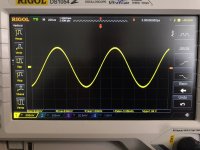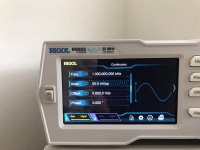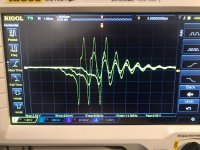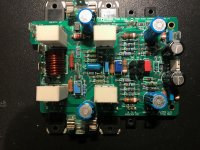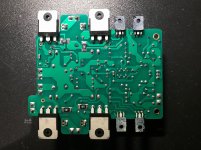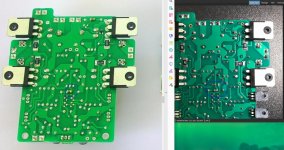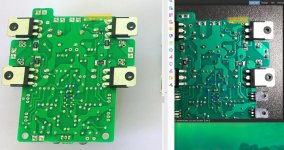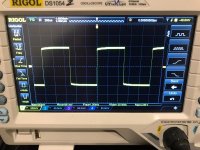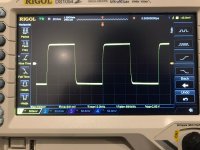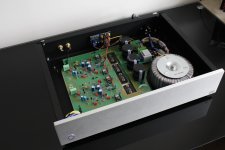Thanks Bonsai and Pitbul. Sorry I think I putted you both onto the wrong conclusions. The amplification factor is 1.94/(50*10-3) =38,8 (at 1000Hz, sine wave). A bit higher, but no exotic deviations. I conducted the measurements Bonsai requested:
Junction R28/29 to GND = 15.3 ohm (both channels the same)
R12-R16; I thought yes, found it! I measured 22 ohms... however the dummy load was still connected :-(
Without the dummy I measured 522.8 ohms left ch 524.4 ohms right ch. A bit lower, but no shocking values.
Junction R28/29 to GND = 15.3 ohm (both channels the same)
R12-R16; I thought yes, found it! I measured 22 ohms... however the dummy load was still connected :-(
Without the dummy I measured 522.8 ohms left ch 524.4 ohms right ch. A bit lower, but no shocking values.
Attachments
Last edited:
Looks like I cross posted - those figures are ok. I'll have to think about this for a bit. Never had this issue on a nx-Amp before.
I've had the amp up on the sim today and there's 12 dB gain margin and 70 deg phase margin - so no issue there from what I can see.
As an experiment, could you replace C7 with 150pF and lets see what that does.
I've had the amp up on the sim today and there's 12 dB gain margin and 70 deg phase margin - so no issue there from what I can see.
As an experiment, could you replace C7 with 150pF and lets see what that does.
Thanks Bonsai, that would be very nice. I just replaced the cap. First with a very nice silver mica cap that I apparently had in stock of also 68pF. Unfortunatelly no effect. I changed C7 to 150pF. Also no effect. So those old Phillies are trustworthy and not the issue.
To be really sure I checked again all components very meticulous. But can not spot any mistake  . There is one deviation I have used a BC847CW instead of a BC847C as thermal compensation transistor, but that could not explain the issue. Tested a bit further. Only thing I could find is that the SSRL kicks in when there is oscillation and R19 or R18 are touched. When **** down there is a bit of noise. I discovered that R19 gets a bit hot when the amp is singing/oscillating aloud. The same effect can be obtained by touching R18. It is channel independent.
. There is one deviation I have used a BC847CW instead of a BC847C as thermal compensation transistor, but that could not explain the issue. Tested a bit further. Only thing I could find is that the SSRL kicks in when there is oscillation and R19 or R18 are touched. When **** down there is a bit of noise. I discovered that R19 gets a bit hot when the amp is singing/oscillating aloud. The same effect can be obtained by touching R18. It is channel independent.
 . There is one deviation I have used a BC847CW instead of a BC847C as thermal compensation transistor, but that could not explain the issue. Tested a bit further. Only thing I could find is that the SSRL kicks in when there is oscillation and R19 or R18 are touched. When **** down there is a bit of noise. I discovered that R19 gets a bit hot when the amp is singing/oscillating aloud. The same effect can be obtained by touching R18. It is channel independent.
. There is one deviation I have used a BC847CW instead of a BC847C as thermal compensation transistor, but that could not explain the issue. Tested a bit further. Only thing I could find is that the SSRL kicks in when there is oscillation and R19 or R18 are touched. When **** down there is a bit of noise. I discovered that R19 gets a bit hot when the amp is singing/oscillating aloud. The same effect can be obtained by touching R18. It is channel independent.Attachments
Last edited:
Michael,
Can you disconnect one channel (just take the fuses out). Let’s just work on one channel at a time.
The BC847CW is ok.
Can you measure R38, 39, 40 and 50 and then also R41 and R42
Also the volt drop across R24 and R25 - should be. 82 mV +- 10 mV after warming up.
Can you disconnect one channel (just take the fuses out). Let’s just work on one channel at a time.
The BC847CW is ok.
Can you measure R38, 39, 40 and 50 and then also R41 and R42
Also the volt drop across R24 and R25 - should be. 82 mV +- 10 mV after warming up.
Last edited:
Hi Andrew,
Hereby two high res pictures of the board (they need some cleaning I see ;-)).
Ps. there seems to be something different, but I am not completely sure if that is due to the picture. See pict. 3
Regards,
Michael
Hereby two high res pictures of the board (they need some cleaning I see ;-)).
Ps. there seems to be something different, but I am not completely sure if that is due to the picture. See pict. 3
Regards,
Michael
Attachments
Last edited:
Michael, I will look in the morning. The small change you noted was to improve the bias adjustment- this will not affect your problem.
One source, two preamplifiers, two power amplifiers,two full range, two woofers. - YouTube
Bi amping... Sx for full range speakers, Simpelstark for woofers.
Cd source, PGA2311 drive the SX, dadod's preamplifier drive the Simpelstark.
Bi amping... Sx for full range speakers, Simpelstark for woofers.
Cd source, PGA2311 drive the SX, dadod's preamplifier drive the Simpelstark.
Last edited:
There has been a nice series on BBC called Sherlock. Bonsai and me brought this series more or less into practice ;-).
Short recap: when inducing hum (for example by touching the input sockets) the amplifier oscillates at +200kHz, swinging rail-to-rail and therewith cooking the Zobel resistors quite rapidly.
After lots of measuring and testing we could conclude the boards and parts are OK. The Ovation has an input filter with an Fc of ~723 kHz (1K ohm + 220pF cap). I was able to stop the oscillation by changing C13 from 220pF to 820 pF. This lowers the Fc to ~194 kHz (-3DB point). By doing that I could eliminate the oscillation. As far as I can judge the amp is now stable (see attachments, 1kHz square wave, 2v PkPk and 10kHz square wave, 2v PkPk). When I leave C13 out the amp is very unstable, with lower capacitance for C13 the oscillation frequency seems to increase.
I kept one channel original and putted in the other channel the new 820 pF capacitor so I could compare. You can see that the channel with the 820 pF capacitor rolls off a tiny bit earlier at higher frequencies (RF), but not very significantly (certainly not noticeable in the audioband and far beyond). You see that when I inject a square wave the higher frequencies roll a bit off (a tiny ramp up at the beginning of each square), but that is not different from the other channel with still the 220pF capacitor in place and to be expected as far as I can judge.
The strange thing is that there have been many successful Ovations build and nobody reported this problem. So there must be something in this build that is different. But thus far I could not find a proper explanation. Maybe we will find out later. However, in case somebody experiences the same and notices that the Zobel resistors become hot, maybe this post will help
Short recap: when inducing hum (for example by touching the input sockets) the amplifier oscillates at +200kHz, swinging rail-to-rail and therewith cooking the Zobel resistors quite rapidly.
After lots of measuring and testing we could conclude the boards and parts are OK. The Ovation has an input filter with an Fc of ~723 kHz (1K ohm + 220pF cap). I was able to stop the oscillation by changing C13 from 220pF to 820 pF. This lowers the Fc to ~194 kHz (-3DB point). By doing that I could eliminate the oscillation. As far as I can judge the amp is now stable (see attachments, 1kHz square wave, 2v PkPk and 10kHz square wave, 2v PkPk). When I leave C13 out the amp is very unstable, with lower capacitance for C13 the oscillation frequency seems to increase.
I kept one channel original and putted in the other channel the new 820 pF capacitor so I could compare. You can see that the channel with the 820 pF capacitor rolls off a tiny bit earlier at higher frequencies (RF), but not very significantly (certainly not noticeable in the audioband and far beyond). You see that when I inject a square wave the higher frequencies roll a bit off (a tiny ramp up at the beginning of each square), but that is not different from the other channel with still the 220pF capacitor in place and to be expected as far as I can judge.
The strange thing is that there have been many successful Ovations build and nobody reported this problem. So there must be something in this build that is different. But thus far I could not find a proper explanation. Maybe we will find out later. However, in case somebody experiences the same and notices that the Zobel resistors become hot, maybe this post will help

Attachments
Thanks Michael. This indeed has been a tough problem. Hopefully I can do some further work over the coming weeks to find the root cause of this issue on your build.
@Bonsai: That would be great Andrew and thank you for all your support!!!
@Pitbull: No, everything here is cabled/wifi. But I do know what you mean. I have checked the power sources, tried a mains filter and tried even different electrical groups. Unfortunately I could not alter the effect, making me believe it is not induced by the mains connection.
Unfortunately a party does not last forever. Although I mitigated the phenomenon a lot by exchanging C13 it is still not completely perfect. Somehow, do not as me why, I was able to induce oscillation at a lower frequency. And very specifically when I make connection with a CD-player. More specifically when the RCA is being plugged in, signal in makes contact, just before GND makes contact. When GND is connected everything is fine again. Grrr... oscillation again... but now at 120 kHz. And that is unfortunately way below the Fc. And this time without the lightbulb in series. But fortunately I could save the Zobel and thus the magic smoke. Now, I could increase C13 a bit to lets say 1.5 nF (Fc will then be 88 kHz). But I am afraid that in another, very specific situation we will get again and again oscillation below the Fc. Difficult... I do not really trust this amp as it is now. There must be a fix. What do you think Andrew, shall I leave the NX for a while alone and wait for your results, or shall I increase C13 again?
Ps. I finished a few months ago a Naim NAP200 amplifier. I was yesterday briefly able to listen some music. When the NX did work it was quite competitive to the Naim !
!
@Pitbull: No, everything here is cabled/wifi. But I do know what you mean. I have checked the power sources, tried a mains filter and tried even different electrical groups. Unfortunately I could not alter the effect, making me believe it is not induced by the mains connection.
Unfortunately a party does not last forever. Although I mitigated the phenomenon a lot by exchanging C13 it is still not completely perfect. Somehow, do not as me why, I was able to induce oscillation at a lower frequency. And very specifically when I make connection with a CD-player. More specifically when the RCA is being plugged in, signal in makes contact, just before GND makes contact. When GND is connected everything is fine again. Grrr... oscillation again... but now at 120 kHz. And that is unfortunately way below the Fc. And this time without the lightbulb in series. But fortunately I could save the Zobel and thus the magic smoke. Now, I could increase C13 a bit to lets say 1.5 nF (Fc will then be 88 kHz). But I am afraid that in another, very specific situation we will get again and again oscillation below the Fc. Difficult... I do not really trust this amp as it is now. There must be a fix. What do you think Andrew, shall I leave the NX for a while alone and wait for your results, or shall I increase C13 again?
Ps. I finished a few months ago a Naim NAP200 amplifier. I was yesterday briefly able to listen some music. When the NX did work it was quite competitive to the Naim
 !
!Attachments
You have a very strange problem Michael, and as far as I can tell, the only one out of many dozens built (112 sets sold to date).
I’ve sent you a PM - hopefully we can resolve it.
I’ve sent you a PM - hopefully we can resolve it.
Instability
Check your amplifier without the RC inputfilter (fitted), feed the amp with a square wave and load the output with a resistive dummy-load.
Check the output signal for (heavy) ringing.
Second: connect a 100nF parallel to the load and check again.
The Fc of the input filter should normally not exceed 200kHz.
Check your amplifier without the RC inputfilter (fitted), feed the amp with a square wave and load the output with a resistive dummy-load.
Check the output signal for (heavy) ringing.
Second: connect a 100nF parallel to the load and check again.
The Fc of the input filter should normally not exceed 200kHz.
@Bonsai, hehe, in a way it makes this amplifier for sure one of a kind ;-)
@Piersma, thanks for your feedback! I have uploaded multiple pictures of the square wave response a few posts ago (nothing strange to see). Without the RC the amplifier relapses into heavy oscillation. By lowering the Fc I am able to tackle most oscillation. However, with the CD-player I am able to induce 100kHz oscillation which is amplified happily by the Ovation. I could tweak the RC a bit more, but I am afraid I am addressing the symptom instead of the cause :-(
@Piersma, thanks for your feedback! I have uploaded multiple pictures of the square wave response a few posts ago (nothing strange to see). Without the RC the amplifier relapses into heavy oscillation. By lowering the Fc I am able to tackle most oscillation. However, with the CD-player I am able to induce 100kHz oscillation which is amplified happily by the Ovation. I could tweak the RC a bit more, but I am afraid I am addressing the symptom instead of the cause :-(
We’ve looked closely at the loop stability. The 68 pF comp cap has been checked -it’s ok. The comp scheme provides c. 80 deg phase margin and >15 dB gain margin. The amp has an output coupling coil (0.6uH) and a Zobel so it can handle capacitive loads.
Voltages across the resistors have been checked and are ok.
Tweaking the input filter cap is not solving the root cause of this problem. The oscillation frequency is in the ballpark (c. 200 kHz) to make it look like it’s loop related and not parasitic oscillation which would normally be in the MHz region.
The amp is oscillating into a resistive load, so doing tests with a capacitive load at this stage will not help.
Voltages across the resistors have been checked and are ok.
Tweaking the input filter cap is not solving the root cause of this problem. The oscillation frequency is in the ballpark (c. 200 kHz) to make it look like it’s loop related and not parasitic oscillation which would normally be in the MHz region.
The amp is oscillating into a resistive load, so doing tests with a capacitive load at this stage will not help.
- Home
- Amplifiers
- Solid State
- SX-Amp and NX-Amp
